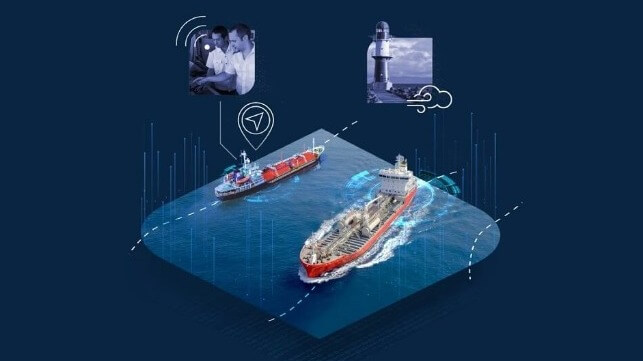Interview: Nicholas Bourque, CSO of OneOcean

 The Maritime Executive’s Tom Cox recently down with Nicholas Bourque, Chief Strategy Officer of digital solutions provider OneOcean, to see how things have been going in 2022.
The Maritime Executive’s Tom Cox recently down with Nicholas Bourque, Chief Strategy Officer of digital solutions provider OneOcean, to see how things have been going in 2022.
Since 2019 and the merger of Marine Press with Chartco, we have had a global pandemic and now the Russia/Ukraine war, so a very challenging start for the newly formed OneOcean. How has it been going behind the scenes at the largest global supplier of navigation solutions to the maritime industry?
Yeah, I think we were quite lucky out of the gate. Having a lot of our internal operations already digitized, meant we were able to transition to a work from home model fairly easily. This meant that during the first waves of the pandemic when everyone was working solely from home, we didn’t struggle too much with business continuity.
Our offices work together, but we also have various teams specializing in individual products, in different locations, and we took this time to focus a lot on product development. We also managed some major acquisitions during that time. So, this ended up being a fairly active and busy time for us; we didn't see any real slowdown.
Brilliant. And can you tell us some more about the acquisitions?
Yes, we acquired Shipping Guides, primarily for access to the valuable port data contained in the Guide to Port Entry publications and the findaport.com website. We were looking to expand our data sets and we chose this organization because their data complements our environmental database and our Regs4ships regulatory data.
Our industry has so many regulations now, especially regarding environmental factors, from authorities at all levels. There are environmental regulations from the IMO to national, regional, local, and port levels. So having the ability to source port data and tie that in with our offering was really interesting for us and very valuable for our customers.
Nice. So, with COVID forcing a lot of owners to speed up the pace of digitalization has OneOcean increased your network during the pandemic?
Yeah, very much so. And I think more importantly, many of our existing customers have definitely been interested in digital products to bridge the gaps imposed by the pandemic. We’ve seen many of our well-established customers progress on their own digital journeys. Many are looking not just for customizable digital products, but for solutions that could replace entire processes, which we were really well positioned to provide with both our navigation and environmental suite.
Fantastic. So that answers my second question: did you see more owners using different parts of your services?
Absolutely. Yes.
So, what is the focus for OneOcean moving forward?
So, the big thing we have started to do is understand the digital maturity process for ship owners, which means understanding that their needs are slightly different in terms of data flexibility. So, what we've been really working on is APIs, which we will be launching in the next few months. So, all the data and algorithms we use internally to build our products, we are now building in a way that they can meet the needs of a different type of customer. An example of that would be large customers who run fleet operation centres. Although they want the OneOcean software onboard the ship, they also want access to this same data, in a way that they can combine it with their own business systems. So, we are building everything to be able to do that, which in turn allows us to provide more value, by offering more flexibility in the digital options we can offer our customers.
What are some of the main fleet management challenges that some of the shipowners are facing at present?
Well, let’s start with decarbonization and all the MARPOL Annex VI environmental regulations. People tend to look at them as a timeline of different requirements entering into force where you say, oh, well this is going to be the action date, but it’s easy to lose track of the cumulative effect of all these new regulations that have gradually entered into force over the past seven years. For someone on board, it's just one requirement on top of another.
So, the question we've looked at addressing is how do you operationalize meeting all these new requirements consistently at a fleet level? What are the systematic processes you put in place to ensure compliance in the present, and the agility to comply with future regulations? We've identified the importance of empowering multidimensional, dynamic decision-making in the voyage planning and monitoring processes. We want to allow all stakeholders, aboard and ashore to assess all the information they need to make complex decisions faster. The OneOcean platform provides access – including visual access -- to interconnected data at a high and detailed level. So, everyone can evaluate situations from a holistic standpoint and see a clear picture of what they need to comply with, when and where.
And what are the main environmental regulations that you guys are coming up against currently?
Well, we’ve seen huge impacts from regulations concerning ballast water and any regulation that involves having to derate your engine. Both have had huge implications on voyage planning. For engine derating for instance, it now means that you no longer have as much flexibility in avoiding or going through adverse weather the same way, because you don't have the same power.
As far as operational planning goes, if you don't plan your ballast operations correctly and you take on ballast in one port without knowing your next destination, that might mean that you can't discharge or load ballast in the next port, which could present a bit of a headache.
Right, depending on the hold time.
Yeah, and the area, and then you open the Pandora's box of having to change the voyage and the carbon footprint consumption everything that's going to have as impact.
So, using the OneOcean platform, the owner would get a bigger and broader picture of their voyage plan?
We're the only company that allows you to look at the navigational safety, the overview of a performance index around weather optimization and environmental all within the same software and on the same interface. Seeing all this data on one screen allows you to visualize how various factors come together to affect voyage planning. You can say, well, I am going to make this decision because of these factors, because you’re seeing everything in context and you can assess pretty quickly within a few minutes, rather than a few hours, what's the impact of changing a voyage plan.
And now, with our new API offering, we're going to be giving that same data to them so that now they can integrate it with their own systems to get even more value. Shoreside users can see the context of the decisions being made aboard, and more easily analyse onboard events and get that level of insight that allows them to improve.
And is there anything else you'd like to let our readers know?
I think a lot of companies are afraid of digitization and perhaps daunted at the prospect of replacing their existing processes. But there is so much value to be realized in digitization – just the structure of the information you start to collect, which can allow you to automate so much of the reporting being done.
We’re advising our customers on implementing a three-step approach of, okay, first let's structure your information, then let's give you something that can allow you to dynamically make decisions, and then you can report almost by snapping your fingers.
The opinions expressed herein are the author's and not necessarily those of The Maritime Executive.

